Sound Art

TRACK_48N10E
University of Applied Sciences Augsburg and TUM/MCTS: Adrian Ludwig (HS Augsburg), Florian Kapaun (HS Augsburg), Johannes Weigele (HS Augsburg), Codrin Podoleanu (HS Augsburg), Benedikt Friedl (HS Augsburg), Simon Hofmeister (HS Augsburg), Linda Ma (HS Augsburg), Dennis Appelt (TUM), Carmen Bozga (TUM), Paola Segovia Alvarado (TUM), Xinghan Liu (TUM) Supervisors: Prof. Andreas Muxel, Elias Naphausen, Jan-Hendrik Passoth
TRACK_48N10E is a location-based, real-time application, mapping your surroundings to a virtual synthesizer. The mobile, web-based reality extension enables users to perceive their sonified environment while strolling. The soundscape is dynamically generated by urban and rural features of site-specific map data and changes with every single step. TRACK_48N10E encourages the exploration of known and unknown places by ear. Two places never look the same and therefore never sound the same. With each step the listener dives further into a unique, extended reality.

STORIES OF AN INSTANT
LMU Munich and TUM/MCTS: Lucas Fellner (LMU), Viktoria Lubomski (LMU), Claudius Budcke (LMU), Lorenz Meyn (LMU), Ferdinand Domes (LMU), Joanne Arkless (TUM), Cynthia Yee Ting Ng (TUM) Supervisors: Dr. Karin Guminski, Aida Bakhtiari, Jan-Hendrik Passoth
STORIES OF AN INSTANT exemplifies a variety of perspectives created by the societal circumstances of COVID-19. To stimulate a change of perspective and awake empathy the project includes voice recordings of people affected by the crisis. By assigning different stories to meaningful objects, STORIES OF AN INSTANT creates separated areas, each defined by a strong symbolic language. Based on exploration of situated knowledges and the duality of objectivity-relativism, the project challenges one's view of their own truth – striving to showcase considerable perceptions of others.
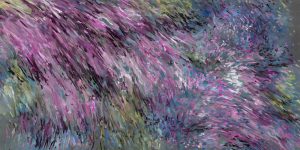
Transient - Impermanent paintings
Quayola (IT)
Transient - Impermanent paintings is an audiovisual concert for two motorized pianos and two conductors in collaboration with generative algorithms. Hyper-realistic digital brushstrokes articulate endlessly on a large-scale projection as if on a real canvas. Each brushstroke is sonified with a piano note, creating polyphonic synesthetic landscapes.
AI x MUSIC: Artificial Creativity or Enhanced Humanity
The Grid (US/EU), Christine Payne (US), Monica Dinculescu (US), Ali Nikrang (AT), Clara Blume (AT/US)
The music industry was transformed drastically over the past couple of decades. For better or worse, these developments are tied to technological advancements and a rapidly adapting consumer behavior. Tech companies are invested in a future where AI forms an indispensable part of the creative process. Recent breakthroughs are already paving the way for music that is entirely created and performed by algorithms. But does that make AI an artist?

Garden of Third Life Conference
The Online Lecture Series aims to share the main discourse on the “Garden,” the central theme of Ars Electronica, and the “Third Life” of the Korea National University of Arts.
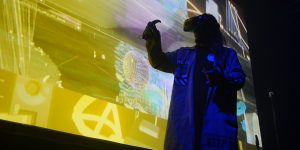
Late Night Party.
The Glad Scientist and TribeXR
Live Music/ VR experience/ performance The Glad Scientist, is an innovative genre pushing virtual reality artist and musician. He is based in Osaka, however his work is known worldwide. His work includes live Audio Visual performances incorporating EKG technology, VR, and more: VR DJ dance party Sponsored by TribeXR will be a fun addition to the dome allowing a place to break free, dance, and enjoy the talents of worldwide Virtual Reality DJ’s.
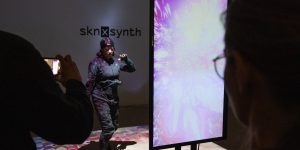
SKNXSYNTH
Performer: Anna Pompermaier (AT), Project Artists: Cenk Guzelis (AT), Josecarlos Florez (PE), Mohsen Hazrati (IR)
A xenotransplantative skin Live Performance/ Digital interaction The xenotransplantative skin project behaves as a digital skin that interfaces human and non-human entities to change spatial perception, create sensual friction, construct a self-image through detachments from bodily self and a space of negotiation between the self and the other self, oscillating between virtual and physical.
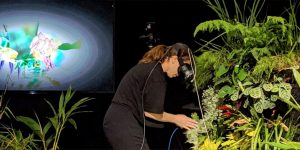
Ars Electronicas Garden Newcastle: We Guide You Tour
University of Newcastle (AU), FASTLab (AU), Art Thinking Australia (AU)
A tour of the Ars Electronica Garden Newcastle that focuses on the overarching theme of Ecology that spans both the natural and artificial world. Inspired by the Ars Electronica We Guide You format, the tour also provides a unique lens into the Newcastle culture.

WADS (↑ ← → ↓) Exhibition in Mozilla Hub
RISE ITICA (CY)
WADS, a digital garden of commoning formed by 21 local artists, sets out to explore the potential of digital hubs as grounds of artistic and technological co-creation. The digital exhibition is created and experienced in the online environment of Mozilla Hubs and will be accessible through the Ars Electronica Digital Platform.

Can we do the same with less - AI in 64 Kb
Philippe Esling (FR)
This hands-on workshop for the AIxMusic Hackathon by Philippe Esling (FR) introduces techniques for lightweight AI, demonstration of embedded technologies and a 64 Kb competition for an AIxMusic hackathon project challenging the current limits of AI and inspired by the Demoscene and the 64Kb competitions.

AI Creative Agents: The Man I Love
Hervé Sellin (FR), Remi Fox (FR)
The Musical Representations team in the STMS laboratory at IRCAM is working on "cyber-human" systems. Just as cyber-physical systems create a continuity between the digital logic of computers and the physical world by capturing, modeling, and modifying it, they establish a creative continuity between machines and musicians using mathematical modeling and artificial intelligence.

Little Etudes for Piano
Elaine Chew (US/GB)
Little Etudes is a series of short piano pieces based on cardiac electrical anomalies. Aberrant electrical activity in the heart can cause the heart to beat irregularly. Abnormal heart rhythms form interesting musical patterns, which raises the question of whether all natural-sounding musical rhythms have a physiological basis.
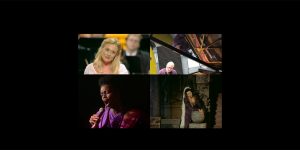
Three Ladies Project
Georges Bloch (FR)
Billie Holiday, Édith Piaf and Elisabeth Schwarzkopf are three great ladies of music, born in 1915. Could we make them sing together? This was the subject of a performance conceived for the music festival Le pietre che cantano in L'Aquila (Italy) in 2015. Using DYCI2Lib software, the three ladies finally sing The Man I Love together. ImproteK, the earlier version of DYCI2Lib, already made it possible to intelligently link the harmony of the base material used (called "memories") to the harmonic progression of the reference song (called "scenario").

Talk: Frontiers of Music and Artificial Intelligence
IRCAM (FR)
Artificial intelligence plays an increasingly prominent role in music composition, performance, and production. How does this benefit or undermine musicians? Where are such developments taking us? Two young protagonists at the leading edge of AIxMusic will debate the limits and future directions of AIxMusic, tackling topics ranging from classic questions of AI takeover to therapeutic and gaming applications to discussions of lightweight deep AI, of uncertainty and unknown models and dimensions.
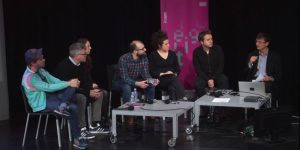
Talk: Musical Generativities (Facilitated by H.Vinet)
IRCAM (FR)
Techniques for the automatic generation of music – which have long been focused on systems ruling the score – are now being deployed at all levels of sound representation: signal, gesture, symbol, form. Sound synthesis using deep networks constitutes a radical break with conventional modelling approaches. How do composers handle these emerging possibilities?
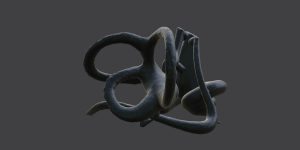
Ars Electronica Barcelona Garden Show
EXHIBITION: The show will present the most recent productions and acquisitions of .BEEP {collection;}: the historical works Das tangible Bild and The Endless Sandwich both by Peter Weibel and Vestibular_1 by Albert Barqué-Duran & Marc Marcenit. Three brand new works will also be exhibited, produced thanks to grants awarded to Mónica Rikić by New Home of Mind, Roc Parés by Doble Consciència and Santi Vilanova (Playmodes) by Forms. The three projects have been selected through a public call of the Institut Ramon Llull, NewArtFoundation and Hangar.

Algorave by Toplap Barcelona (ES)
Toplap Barcelona (ES)
LIVE PARTY/ MUSIC EVENT Algoraves bring together the improvisation and the code scope of a live coding session with the languages and the rituals of the dance floor. During the live writing and reading of the code, and the unfolding of the musical improvisation, the audience dances, thinks and listens in a uniquely intertwined way, helping musicians make sense and do the real creative work in making a great party.
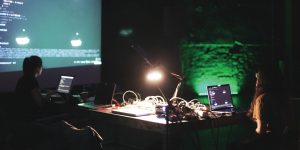
On Code. The Uncertainty Of Meaning And Doing
Lina Bautista (CO), Daniel Moreno Roldán (ES), Agnès Pe (ES), Ángel Faraldo (ES), Carolina Jiménez (ES), Lluís Nacenta (ES)
ROUNDTABLE: How does code interfere with the listening process? Code allows the ear to navigate the listening interface, while it happens to narrow its sensitive scope. It crosses the interface, the membrane which separates but also connects, unfolding the vibration of the air, the zone of inter/intra-action, negotiation and distribution of attention and meanings, between the (dis)orders of the emitted and the heard sounds.
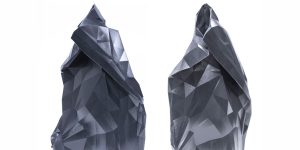
Uncertainty with AI-terity
Koray Tahiroğlu (FI/TR)
The composition Uncertainty keeps the musician in a hesitant state of performance, providing a non-rigid but identifiable musical events, followed by ever shifting new sounds. Uncertainty is a composition written for the AI- terity instrument that comprises computational features of a particular artificial intelligence (AI) model to generate relevant audio samples for real- time audio synthesis. The unusual behaviour of the Al-terity puts the performer in an uncertain state during performance. Together with being able to move through timbre-changes in sonic space, the emergence of new sounds allows the musician to explore a whole new range of musical possibilities. Composition turns into a continuous state of playing, reformulating an idiomatic relationship with the Al-terity and opening up a fresh variety of musical demands.
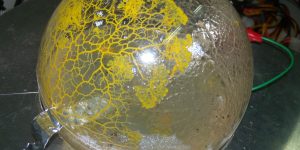
On Bio_Sonic_Agencies.
Brandon LaBelle (US), Robertina Šebjanič (SI), Oscar Martín (ES), Vanessa Lorenzo (ES), Laura Benítez (ES).
ROUNDTABLE: In a world dominated by the visual, could contemporary resistances be auditory? What is the materiality of sound? How does the materiality of sound affect listening? What resistances can be configured from working with biomaterials and sound? Do these bio_sonic_agencies open up other possible spaces that do not exist in the visual regime?


